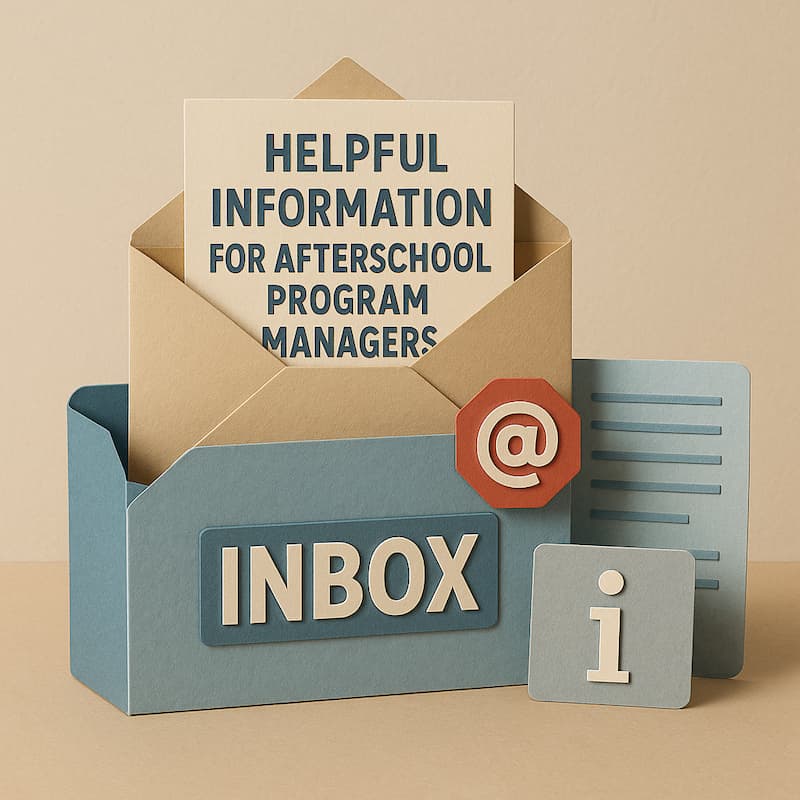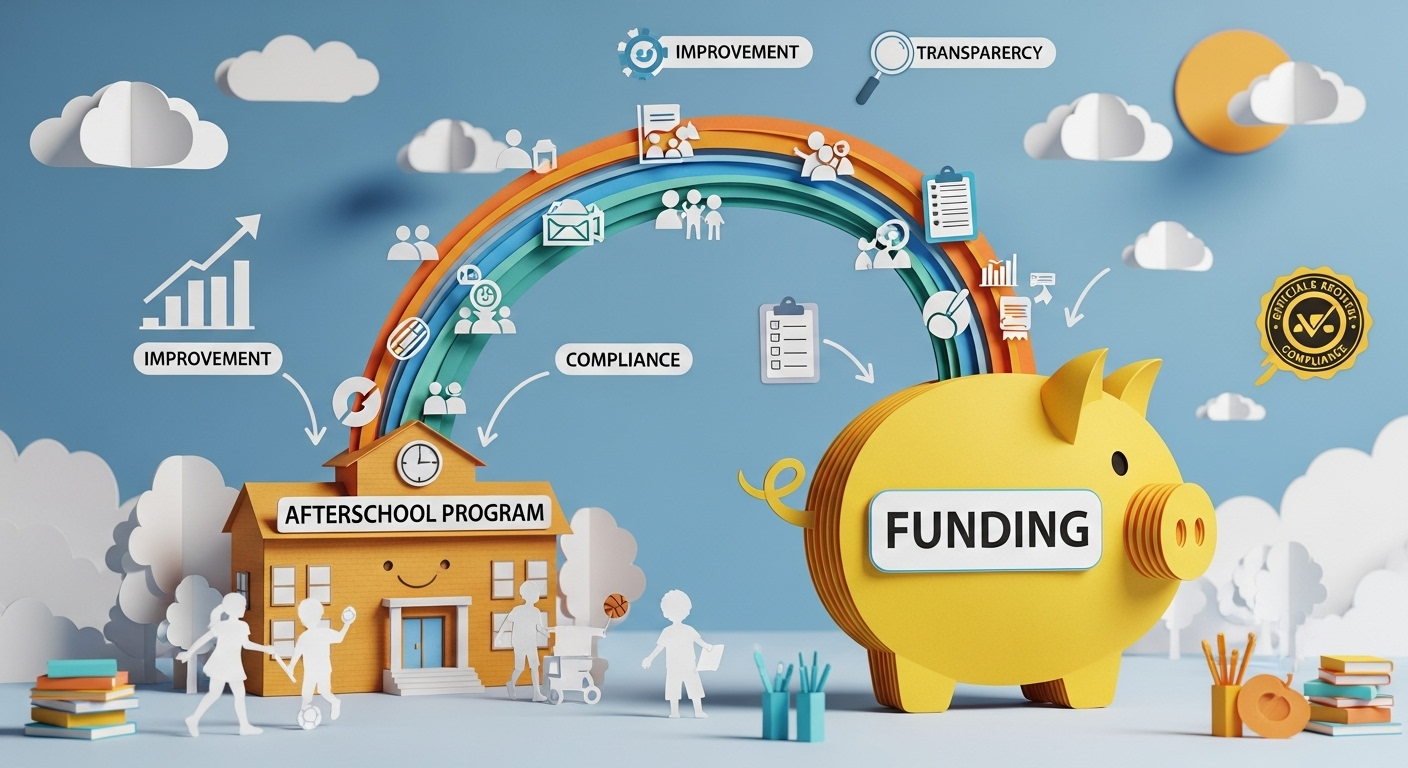
California ELOP Grant Application Question Analysis
Crucial for funding. Crucial for students. Crucial for your program's future. The California ELOP grant application is a process that districts must master to unlock program potential. As an Expanded Learning Director in California, few tasks are as crucial – or as daunting – as completing the ELOP grant application. With substantial funding on the line and the potential to dramatically impact your students' lives, the pressure to get it right can be overwhelming. Each question feels like a make-or-break moment, and you find yourself second-guessing every response.
But what if you could approach this application with confidence, armed with insights from successful submissions and a clear understanding of what reviewers are looking for?
Welcome to our comprehensive guide on mastering the California ELOP grant application. In this article, we'll walk you through each key question, providing:
- Analysis of common themes in successful applications
- Insights into what state reviewers are likely expecting to see
- Examples of standout responses that set applications apart
- Practical tips for crafting compelling answers that showcase your program's strengths
Whether you're a first-time applicant or looking to refine your approach, this guide will help you navigate the complexities of the ELOP application process with greater ease and effectiveness. Let's dive in and unlock the funding your students deserve, one well-crafted answer at a time.
Our approach
If you're facing the ELOP grant application with a mix of determination and trepidation, you're not alone. That's why we've undertaken a broad analysis of other ELOP grant applications from various California school districts. Our goal? To provide you with valuable insights and a starting point – not canned answers that you copy and paste into the application.
Here's what we did:
- We reviewed 11 ELOP grant applications from diverse districts across California.
- For each key question, we identified common themes and approaches that appeared in successful applications.
- We analyzed unique or standout responses that seemed particularly effective.
- Based on this analysis, we've compiled insights into what state application reviewers are likely expecting to see.
What you'll find in this article is not a set of answers to fill in the blanks. Instead, we're offering a window into how other districts have approached these questions. This guidance is designed to:
- Spark ideas and inspiration for your own responses
- Help you understand the key elements that reviewers may be looking for
- Provide a framework for showcasing your district's unique strengths and programs
Remember, the most compelling applications are those that authentically represent your district's vision, challenges, and solutions. Use these insights as a springboard to craft responses that are true to your community's needs and your program's goals.
The Districts We Analyzed
These districts represent a diverse range of California school districts that have submitted Expanded Learning Opportunities Program (ELO-P) plans.
- ABC Unified School District
- Acton-Agua Dulce Unified School District
- Arvin Union School District
- Beaumont Unified School District
- Elk Grove Unified School District
- Keyes Union Elementary School District
- Lawndale Elementary School District
- Riverbank Unified School District
- San Diego Unified School District
- Torrance Unified School District
- Val Verde Unified School District
The Application Questions
Here the questions from the Expanded Learning Opportunities Program Plan Guide from the California Department of Education (CDE).
- Safe and Supportive Environment
- Active and Engaged Learning
- Skill Building
- Youth Voice and Leadership
- Healthy Choices and Behaviors
- Diversity, Access, and Equity
- Quality Staff
- Clear Vision, Mission, and Purpose
- Collaborative Partnerships
- Continuous Quality Improvement
- Program Management
Q1: Safe and Supportive Environment
This question asks how your program will ensure student safety and create a supportive atmosphere. The CDE wants to know about your program's location (on-site or off-campus) and the measures you'll take to maintain a secure, nurturing environment.
Common aspects across multiple applications:
- On-campus programs (6/6 plans): All reviewed plans specified that programs would be offered on school campuses.
- Staff training (5/6 plans): Most districts emphasized staff training in areas such as first aid, CPR, emergency procedures, and student safety protocols.
- Alignment with school day safety procedures (4/6 plans): Many districts mentioned that ELO-P safety procedures would align with regular school day safety practices.
- Positive Behavior Intervention and Supports (PBIS) (3/6 plans): Half of the districts explicitly mentioned implementing PBIS in their ELO-P.
- Sign-in/Sign-out procedures (3/6 plans): Several districts detailed specific procedures for student check-in and check-out.
Unique aspects:
- Val Verde USD mentioned providing portable classrooms and shade structures specifically for the ELO-P.
- Torrance USD highlighted their partnership with YMCA for implementing their program.
- Beaumont USD mentioned implementing the RULER approach for social-emotional learning.
Analysis:
On-campus programs ensure a familiar, accessible environment for students. Staff training in safety procedures is crucial for student well-being. Aligning with school day procedures provides consistency for students and staff. PBIS implementation supports a positive learning environment.
Unique aspects could be advantages. Val Verde's investment in specific ELO-P facilities shows commitment to the program. Torrance's YMCA partnership leverages community resources. Beaumont's RULER approach demonstrates a focus on emotional intelligence.
Based on our analysis of how other schools answered this question, a State of California application review would likely expect to see:
- Clear statements about program location (typically on-campus)
- Emphasis on staff training in safety procedures
- Alignment with existing school safety protocols
- Implementation of positive behavior support systems
- Detailed sign-in/sign-out procedures
They might also expect to see some unique approaches that reflect each district's specific resources, partnerships, or focus areas.
Q2: Active and Engaged Learning
Here, the CDE is looking for details on how your program will keep students actively involved in learning. They want to see that your activities support or supplement, but don't duplicate, the regular school day curriculum.
Common aspects across multiple applications:
- Hands-on, project-based learning (5/6 plans): Most districts emphasized interactive, experiential learning activities.
- STEM/STEAM focus (4/6 plans): Many districts highlighted science, technology, engineering, arts, and math activities.
- Enrichment activities (4/6 plans): Districts commonly mentioned offering various enrichment programs beyond core academics.
- Alignment with school day curriculum (4/6 plans): Many plans stressed that ELO-P activities would support and complement, but not duplicate, regular school day learning.
- Student input on activities (3/6 plans): Half of the reviewed plans mentioned gathering student feedback to inform program offerings.
Unique aspects:
- Elk Grove USD detailed specific curriculum resources like CREST and TeachRock.
- Beaumont USD mentioned implementing AVID strategies in their program.
- Arvin Union School District highlighted the use of TCM materials for language arts and math support.
Analysis:
Hands-on, project-based learning engages students actively. STEM/STEAM focus aligns with current educational priorities. Offering enrichment activities provides a well-rounded experience. Aligning with school day curriculum ensures continuity of learning. Incorporating student input increases engagement and relevance.
Unique aspects could be advantages. Elk Grove's specific curriculum choices demonstrate thoughtful program design. Beaumont's AVID implementation shows a focus on college readiness. Arvin's use of specific materials indicates attention to core academic support.
Based on our analysis of how other schools answered this question, a State of California application review would likely expect to see:
- Emphasis on interactive, hands-on learning experiences
- Focus on STEM/STEAM activities
- A range of enrichment offerings
- Clear connections to school day learning, without duplication
- Some mechanism for incorporating student interests into programming
They might also expect to see examples of specific curricula or approaches that reflect each district's unique resources and priorities.
Q3: Skill Building
This question focuses on how your program will help students develop new skills. The CDE is interested in seeing a range of skill-building opportunities that contribute to students' overall development.
Common aspects across multiple applications:
- Focus on 21st century skills (5/6 plans): Most districts emphasized developing skills like critical thinking, communication, collaboration, and creativity.
- Academic support (5/6 plans): Nearly all plans mentioned providing tutoring, homework help, or other academic assistance.
- Social-emotional learning (SEL) (4/6 plans): Many districts included SEL as a key component of skill building.
- Technology integration (4/6 plans): Several plans highlighted the use of technology to support skill development.
- College and career readiness (3/6 plans): Half of the reviewed plans mentioned activities or programs aimed at preparing students for future academic and professional pursuits.
Unique aspects:
- San Diego USD mentioned specific programs like "Leader in Me" for leadership skill development.
- Elk Grove USD detailed a comprehensive STEM & Coding for All initiative.
- Arvin Union School District highlighted the use of AVID strategies to support college and career readiness.
Analysis:
Focusing on 21st century skills prepares students for future success. Academic support helps close learning gaps. Incorporating SEL supports whole-child development. Technology integration aligns with modern skill needs. College and career readiness activities provide long-term vision for students.
Unique aspects could be advantages. San Diego's "Leader in Me" program shows a strong focus on leadership development. Elk Grove's comprehensive coding initiative demonstrates a forward-thinking approach to technology skills. Arvin's use of AVID strategies indicates a systematic approach to college preparation.
Based on our analysis of how other schools answered this question, a State of California application review would likely expect to see:
- Clear articulation of targeted skills, especially 21st century competencies
- Description of academic support structures
- Inclusion of social-emotional learning components
- Examples of how technology will be used to support skill building
- Some mention of how the program prepares students for future academic and career success
They might also expect to see specific programs or approaches that align with each district's particular goals and resources.
Q4: Youth Voice and Leadership
The CDE wants to know how your program will empower students by giving them a voice and leadership opportunities. They're looking for ways you'll actively involve students in program decisions and leadership roles.
Common aspects across multiple applications:
- Student advisory groups/councils (5/6 plans): Most districts mentioned forming student groups to provide input on program design and activities.
- Student surveys (4/6 plans): Many districts use surveys to gather student feedback and preferences.
- Leadership opportunities (4/6 plans): Several plans highlighted specific roles or activities for students to develop leadership skills.
- Student choice in activities (4/6 plans): Most districts mentioned allowing students to choose from a range of activities or clubs.
- Community service projects (3/6 plans): Half of the reviewed plans included community service as a way for students to exercise leadership.
Unique aspects:
- Elk Grove USD mentioned a "Club Development Process" where students can create their own clubs.
- Arvin Union School District highlighted the use of the WE Schools program for youth development.
- Beaumont USD mentioned implementing Safe School Ambassadors program.
Analysis:
Student advisory groups provide a formal structure for youth input. Surveys ensure broad feedback collection. Leadership opportunities allow practical skill development. Offering choice in activities increases engagement. Community service projects connect students to their broader community.
Unique aspects could be advantages. Elk Grove's club development process empowers students to take initiative. Arvin's use of WE Schools shows a focus on global citizenship. Beaumont's Safe School Ambassadors program demonstrates a peer-to-peer approach to school climate improvement.
Based on our analysis of how other schools answered this question, a State of California application review would likely expect to see:
- Description of formal structures for gathering student input (e.g., advisory groups, surveys)
- Examples of leadership roles or opportunities for students within the program
- Explanation of how student choice is incorporated into program offerings
- Some mention of community engagement or service learning
- Emphasis on how youth voice influences program design and implementation
They might also expect to see specific programs or approaches that reflect each district's unique vision for youth leadership and empowerment.
Q5: Healthy Choices and Behaviors
This question addresses how your program will promote health and wellness. The CDE is particularly interested in your plans for nutritious meals/snacks and activities that encourage healthy lifestyles.
Common aspects across multiple applications:
- Nutritious meals/snacks (6/6 plans): All districts mentioned providing healthy food options that meet USDA guidelines.
- Physical activity programs (5/6 plans): Most districts emphasized incorporating regular physical activity or sports.
- Nutrition education (4/6 plans): Many plans included components to teach students about healthy eating habits.
- Social-emotional learning (SEL) activities (4/6 plans): Several districts integrated SEL into their health and wellness approach.
- Collaboration with district food services (3/6 plans): Half of the plans explicitly mentioned working with their district's food services department.
Unique aspects:
- Elk Grove USD detailed specific programs like CATCH Kids Club and Soccer for Success.
- Arvin Union School District mentioned using Fitness Skillastics combined with Nutritional cards.
- Beaumont USD highlighted their partnership with the Lamont Family Resource Center for nutrition education.
Analysis:
Providing nutritious meals supports students' physical health. Regular physical activity promotes overall wellness. Nutrition education empowers students to make informed choices. Incorporating SEL recognizes the connection between emotional and physical health. Collaborating with food services ensures consistency and quality.
Unique aspects could be advantages. Elk Grove's use of specific, evidence-based programs shows a commitment to quality implementation. Arvin's use of Skillastics demonstrates an innovative approach to combining physical activity with nutrition education. Beaumont's partnership with a community resource center indicates a holistic approach to health education.
Based on our analysis of how other schools answered this question, a State of California application review would likely expect to see:
- Clear description of meal/snack provision that meets nutritional guidelines
- Examples of physical activities or sports programs offered
- Some form of nutrition education component
- Integration of social-emotional learning with physical health initiatives
- Mention of how the program collaborates with existing school health initiatives or departments
They might also expect to see specific programs, partnerships, or approaches that reflect each district's unique resources and health priorities.
Q6: Diversity, Access, and Equity
Here, the CDE wants to see how your program will ensure it's inclusive and accessible to all students, including those with disabilities. They're looking for strategies that address cultural and linguistic diversity.
Common aspects across multiple applications:
- Priority enrollment for target groups (5/6 plans): Most districts mentioned prioritizing enrollment for unduplicated pupils (low-income, English learners, foster youth).
- Staff training on diversity and inclusion (4/6 plans): Many districts emphasized professional development for staff on cultural competency and equity.
- Accommodations for students with disabilities (4/6 plans): Several plans detailed how they would support students with special needs.
- Multilingual communication (4/6 plans): Most districts mentioned providing program information in multiple languages.
- Culturally relevant programming (3/6 plans): Half of the plans explicitly mentioned incorporating culturally diverse content or activities.
Unique aspects:
- Elk Grove USD mentioned specific partnerships with organizations like Girls Who Code to promote diversity in STEM.
- Torrance USD highlighted their collaboration with the Special Education Department to develop targeted support plans.
- Arvin Union School District mentioned their Dual Immersion Language Program as part of their diversity efforts.
Analysis:
Prioritizing target groups ensures equitable access. Staff training on diversity promotes an inclusive environment. Accommodations for students with disabilities ensure equal participation opportunities. Multilingual communication increases accessibility for families. Culturally relevant programming enhances student engagement and representation.
Unique aspects could be advantages. Elk Grove's partnerships show a proactive approach to addressing underrepresentation in specific fields. Torrance's collaboration with Special Education demonstrates a comprehensive approach to inclusion. Arvin's Dual Immersion program indicates a strong commitment to linguistic diversity.
Based on our analysis of how other schools answered this question, a State of California application review would likely expect to see:
- Clear description of how target student groups are prioritized for enrollment
- Mention of staff professional development related to diversity and equity
- Explanation of how students with disabilities are accommodated
- Information on language access for non-English speaking families
- Examples of how cultural diversity is reflected in program content or activities
They might also expect to see specific initiatives or partnerships that reflect each district's unique demographics and equity goals.
Q7: Quality Staff
This question is about your staffing plans. The CDE wants to know how you'll recruit, train, and retain high-quality staff to work with students in your program.
Common aspects across multiple applications:
- Minimum qualifications for staff (6/6 plans): All districts specified minimum requirements for staff, often aligning with instructional aide qualifications.
- Ongoing professional development (5/6 plans): Most districts emphasized regular training for program staff.
- Recruitment strategies (4/6 plans): Many districts described their approach to recruiting qualified staff.
- Collaboration with regular school day staff (4/6 plans): Several plans mentioned coordination between ELO-P staff and regular teachers or administrators.
- Staff-to-student ratios (3/6 plans): Half of the plans explicitly mentioned maintaining specific staff-to-student ratios (usually 20:1 for general program, 10:1 for TK/K).
Unique aspects:
- Elk Grove USD detailed a comprehensive staff structure including site leaders, program leaders, and various specialized roles.
- Beaumont USD mentioned using the Thoughtful Classroom Teacher Effectiveness Framework for staff evaluation.
- Arvin Union School District highlighted their intention to hire a specific Supervisor II of Expanded Learning to oversee the program.
Analysis:
Setting minimum qualifications ensures a baseline of competency. Ongoing professional development supports continuous improvement. Strategic recruitment helps attract quality candidates. Collaboration with school day staff promotes program alignment. Maintaining appropriate staff-to-student ratios ensures adequate supervision and support.
Unique aspects could be advantages. Elk Grove's detailed staff structure demonstrates thorough program planning. Beaumont's use of a specific evaluation framework shows commitment to staff quality. Arvin's creation of a dedicated supervisory position indicates strong administrative support for the program.
Based on our analysis of how other schools answered this question, a State of California application review would likely expect to see:
- Clear statement of minimum staff qualifications
- Description of ongoing professional development opportunities
- Information on staff recruitment and retention strategies
- Mention of how ELO-P staff collaborate with regular school day personnel
- Specification of staff-to-student ratios, particularly for younger students
They might also expect to see specific staffing structures or evaluation methods that reflect each district's unique program design and resources.
Q8: Clear Vision, Mission, and Purpose
The CDE is looking for a well-defined direction for your program. They want to see that you have a clear understanding of what you're trying to achieve and how it aligns with broader educational goals.
Common aspects across multiple applications:
- Alignment with district goals (5/6 plans): Most districts emphasized how the ELO-P aligns with broader district visions and strategic plans.
- Focus on whole child development (4/6 plans): Many plans explicitly mentioned addressing academic, social-emotional, and physical needs of students.
- Emphasis on providing opportunities (4/6 plans): Several districts framed their vision around expanding learning experiences for students.
- Commitment to equity (3/6 plans): Half of the plans included equity as a key component of their vision or mission.
- Community engagement (3/6 plans): Half of the plans mentioned involving the community in their program vision.
Unique aspects:
- Elk Grove USD included specific learning outcomes in their logic model, such as social-emotional competency and college/career readiness.
- Beaumont USD provided a detailed list of instructional priorities as part of their vision.
- Arvin Union School District incorporated their district's four strategic goals directly into their ELO-P vision.
Analysis:
Aligning with district goals ensures program coherence. Focusing on whole child development supports comprehensive student growth. Emphasizing opportunities aligns with the expanded learning concept. Commitment to equity addresses achievement gaps. Community engagement promotes broader support and resources.
Unique aspects could be advantages. Elk Grove's specific learning outcomes provide clear program direction. Beaumont's detailed instructional priorities demonstrate thorough planning. Arvin's direct incorporation of district goals shows strong alignment with overall district strategy.
Based on our analysis of how other schools answered this question, a State of California application review would likely expect to see:
- A clear statement of how the ELO-P vision aligns with overall district goals
- Mention of supporting the whole child (academic, social-emotional, physical)
- Language about expanding or enhancing learning opportunities
- Some reference to equity or serving all students
- Indication of how the community fits into the program vision
They might also expect to see specific goals, outcomes, or priorities that reflect each district's unique context and aspirations for their expanded learning program.
Q9: Collaborative Partnerships
This question asks about your plans to work with other organizations. The CDE encourages partnerships that can enhance your program's offerings and reach.
Common aspects across multiple applications:
- Partnerships with community organizations (6/6 plans): All districts mentioned collaborating with external organizations to enhance their programs.
- Collaboration with other district departments (5/6 plans): Most districts emphasized internal partnerships, particularly with departments like Nutrition Services and Transportation.
- Partnerships with local educational institutions (4/6 plans): Many districts mentioned collaborations with local colleges or universities.
- Involvement of local government agencies (3/6 plans): Half of the plans mentioned partnerships with city or county agencies.
- Partnerships focused on specific program areas (3/6 plans): Several districts highlighted partnerships targeting specific aspects of their program, such as STEM or arts education.
Unique aspects:
- San Diego USD detailed a partnership with the San Diego Foundation to provide Level Up programming.
- Elk Grove USD mentioned specific partnerships for coding education, including Code.org and Girls Who Code.
- Arvin Union School District highlighted a partnership with the local Lions Club for philanthropic support.
Analysis:
Community organization partnerships expand program offerings and resources. Internal department collaborations ensure efficient use of district resources. Partnerships with educational institutions can provide additional expertise and potential staffing. Local government involvement can offer broader community support. Targeted partnerships can enhance specific program areas.
Unique aspects could be advantages. San Diego's partnership with a local foundation shows strong community support. Elk Grove's specific coding partnerships demonstrate a focus on in-demand skills. Arvin's connection with a philanthropic organization indicates diverse funding sources.
Based on our analysis of how other schools answered this question, a State of California application review would likely expect to see:
- A list of key community partners and their roles in the program
- Description of how various district departments collaborate on the ELO-P
- Mention of any partnerships with local colleges or universities
- Information on collaborations with local government or public agencies
- Examples of how partnerships enhance specific program offerings
They might also expect to see unique partnerships that reflect each district's local resources, priorities, and community connections.
Q10: Continuous Quality Improvement
Here, the CDE wants to know how you'll regularly assess and improve your program. They're looking for a systematic approach to gathering feedback and making enhancements.
Common aspects across multiple applications:
- Regular data collection and analysis (6/6 plans): All districts mentioned gathering and reviewing data to inform program improvements.
- Use of surveys for feedback (5/6 plans): Most districts emphasized collecting feedback from students, parents, and staff through surveys.
- Regular program evaluation cycles (4/6 plans): Many districts described specific timeframes for reviewing and updating their programs.
- Professional Learning Communities (PLCs) or similar structures (3/6 plans): Half of the plans mentioned using collaborative staff groups to discuss and implement improvements.
- Alignment with California Quality Standards (3/6 plans): Several districts explicitly mentioned using the state's Quality Standards for Expanded Learning as a framework for improvement.
Unique aspects:
- Elk Grove USD mentioned using a specific Core Program Assessment (CPA) tool alongside the Quality Self-Assessment Tool (QSAT).
- Torrance USD highlighted their use of the Kern Integrated Data System for real-time data analysis.
- Beaumont USD mentioned using the Thoughtful Classroom Teacher Effectiveness Framework for program improvement.
Analysis:
Regular data collection ensures informed decision-making. Surveys provide valuable stakeholder input. Scheduled evaluation cycles promote consistent improvement. PLCs foster collaborative problem-solving. Alignment with state standards ensures program quality.
Unique aspects could be advantages. Elk Grove's use of multiple assessment tools demonstrates a comprehensive approach to evaluation. Torrance's use of a real-time data system shows commitment to responsive program management. Beaumont's use of a specific framework for teacher effectiveness indicates a focus on instructional quality.
Based on our analysis of how other schools answered this question, a State of California application review would likely expect to see:
- Description of data collection methods and types of data analyzed
- Information on how feedback is gathered from various stakeholders
- Timeline or process for regular program review and improvement
- Mention of collaborative structures for staff to discuss and implement improvements
- Reference to state or national quality standards used to guide improvement efforts
They might also expect to see specific tools, frameworks, or processes that reflect each district's unique approach to quality improvement and data management.
Q11: Program Management
This final question is about the nuts and bolts of running your program. The CDE wants to see that you have a solid plan for day-to-day operations, including staffing, scheduling, and resource management.
Common aspects across multiple applications:
- Clear organizational structure (6/6 plans): All districts outlined a management structure for their ELO-P.
- Defined roles and responsibilities (5/6 plans): Most districts provided detailed descriptions of key staff positions and their duties.
- Integration with existing district structures (4/6 plans): Many districts emphasized how ELO-P management aligns with or fits into broader district management.
- Regular communication protocols (4/6 plans): Several districts mentioned specific meeting schedules or communication channels for program management.
- Fiscal management procedures (3/6 plans): Half of the plans explicitly mentioned processes for budget oversight and financial reporting.
Unique aspects:
- San Diego USD mentioned having a specific ELOP Assistant Principal position to oversee the program.
- Elk Grove USD detailed an "inverted pyramid" structure designed to put children first in their management approach.
- Arvin Union School District highlighted the creation of a new Supervisor II of Expanded Learning position to manage the program.
Analysis:
Clear organizational structure ensures efficient program operation. Defined roles clarify responsibilities and accountability. Integration with district structures promotes cohesion. Regular communication protocols facilitate smooth operations. Fiscal management procedures ensure responsible use of funds.
Unique aspects could be advantages. San Diego's dedicated ELOP Assistant Principal demonstrates strong administrative support. Elk Grove's "inverted pyramid" structure shows a student-centered management philosophy. Arvin's new supervisory position indicates significant investment in program leadership.
A reader of multiple plans would likely expect to see:
- An organizational chart or clear description of program management structure
- Detailed explanations of key staff roles and their responsibilities
- Information on how ELO-P management integrates with overall district management
- Description of regular meetings or communication channels for program oversight
- Mention of processes for budget management and financial reporting
They might also expect to see specific management structures or positions that reflect each district's unique program design and resources.
Previous Version of the CA ELOP Grant Application
While our primary focus is on the current ELOP grant application (released in September 2021), there's still value in examining how schools approached the previous iteration of this grant. The previous version, released in March 2021, may no longer be the active application, but it offers valuable insights that remain relevant to today's applicants.
Why look back?
- Continuity in Core Concepts: Many of the fundamental elements that the California Department of Education (CDE) seeks in expanded learning programs remain consistent across versions. Understanding how schools successfully articulated these core concepts can inform current applications.
- Evolution of Requirements: By comparing these responses to current expectations, we can identify trends in how the CDE's priorities have evolved. This can help predict future directions and ensure your program stays ahead of the curve.
- Diverse Approaches: The variety of responses to Version 2 showcases the creativity and adaptability of California's school districts. These examples can spark ideas for innovative approaches to your current application.
- Learning from Experience: Schools that applied under Version 2 have had time to implement and refine their programs. Their experiences can provide valuable lessons for new applicants or those looking to enhance existing programs.
In the following section, we'll break down each question from the previous version to analyze common themes in responses, and discuss how these insights can be applied to the current application process. Remember, while the specific questions may have changed, the underlying goals of providing high-quality, accessible expanded learning opportunities remain the same.
Let's dive in and see what we can learn from these earlier ELOP grant applications.
Questions
- A description of how parents, teachers, and school staff were involved in the development of the plan.
- A description of how students will be identified and the needs of students will be assessed.
- A description of how parents and guardians of students will be informed of the opportunities for supplemental instruction and support.
- A description of the LEA's plan to provide supplemental instruction and support.
- Expenditure Plan
- A description of how ELO Grant funds are being coordinated with other federal Elementary and Secondary School Emergency Relief Funds received by LEA
Q1. A description of how parents, teachers, and school staff were involved in the development of the plan.
This question seeks to understand how various stakeholders were engaged in developing the plan. The CDE wants to see a collaborative approach that includes diverse perspectives.
Common aspects across multiple applications:
- Stakeholder meetings (5/5 plans): All reviewed plans mentioned holding meetings with various stakeholders including parents, teachers, and staff.
- Surveys (4/5 plans): Most districts used surveys to gather input from parents, staff, and sometimes students.
- Existing committees/groups (3/5 plans): Several districts utilized existing committees or advisory groups for plan development.
- Multiple methods of engagement (3/5 plans): Many districts employed various methods to involve stakeholders, such as meetings, surveys, and informal conversations.
Unique aspects:
- Keyes Union Elementary School District mentioned breaking up their committee into three groups to identify ideas.
- ABC Unified School District specifically mentioned providing equity and cultural proficiency training to staff.
- Elk Grove Unified School District highlighted the use of family advisory groups and student focus groups.
Analysis:
Stakeholder meetings and surveys are clearly best practices, allowing for broad input and engagement. Utilizing existing committees leverages established structures and relationships. Multiple methods of engagement ensure diverse voices are heard.
Keyes' group approach might lead to more diverse ideas. ABC's focus on equity training demonstrates commitment to inclusive planning. Elk Grove's use of student focus groups shows valuing youth voice in the process.
Based on this analysis, a State of California application reviewer would likely expect to see:
- Clear description of stakeholder meetings
- Use of surveys or other data collection methods
- Involvement of existing school/district committees
- Multiple approaches to gathering input
- Efforts to include diverse voices in the planning process
They might also look favorably on unique approaches that demonstrate thoughtful engagement of the community and attention to equity and inclusion.
Q2. A description of how students will be identified and the needs of students will be assessed.
Here, the CDE is looking for your process of identifying students who would benefit from the program and how you'll assess their specific needs. They want to ensure the program targets those who need it most.
Common aspects across multiple applications:
- Use of multiple data sources (5/5 plans): All reviewed plans mentioned using various data sources to identify and assess student needs.
- Academic assessments (5/5 plans): All districts mentioned using academic data, such as grades, standardized test scores, or local assessments.
- Attendance data (4/5 plans): Most districts included attendance as a factor in identifying students.
- Behavioral/social-emotional data (4/5 plans): Many districts considered behavioral or social-emotional factors in their assessment.
- Teacher recommendations (3/5 plans): Several districts mentioned using teacher input to identify students.
Unique aspects:
- Elk Grove USD mentioned using the California Healthy Kids Survey data.
- ABC USD specifically mentioned using iReady Diagnostic for English and Math.
- Keyes Union Elementary School District highlighted the use of a multi-tier system of student support.
Analysis:
Using multiple data sources is clearly a best practice, allowing for a comprehensive view of student needs. Academic assessments provide crucial information about learning gaps. Considering attendance and behavioral data helps identify at-risk students. Teacher recommendations offer valuable insights that may not be captured by quantitative data alone.
Unique aspects could be advantageous. Elk Grove's use of the California Healthy Kids Survey shows attention to broader wellness factors. ABC's specific mention of iReady demonstrates a commitment to using standardized tools. Keyes' multi-tier system suggests a structured approach to identifying and supporting students.
Based on this analysis, a State of California application reviewer would likely expect to see:
- A clear description of multiple data sources used
- Inclusion of academic performance data
- Consideration of attendance and behavioral factors
- Use of teacher input in the identification process
- A systematic approach to assessing student needs
They might also look favorably on districts that demonstrate use of research-based assessment tools and consideration of the whole child in their identification and assessment process.
Q3. A description of how parents and guardians of students will be informed of the opportunities for supplemental instruction and support.
This question focuses on your communication strategy. The CDE wants to know how you'll effectively reach out to families about the opportunities available through the program.
Common aspects across multiple applications:
- Multiple communication methods (5/5 plans): All reviewed plans mentioned using various communication channels to inform parents.
- Written communication (5/5 plans): All districts mentioned using written forms of communication such as flyers, newsletters, or letters.
- Electronic communication (5/5 plans): All districts mentioned using electronic means like emails, websites, or social media.
- Direct contact (4/5 plans): Most districts mentioned some form of direct contact with parents, such as phone calls or in-person meetings.
- Multilingual communication (3/5 plans): Several districts explicitly mentioned providing information in multiple languages.
Unique aspects:
- Elk Grove USD mentioned using a communication software called Talking Points that offers immediate translation in over 100 languages.
- ABC USD highlighted the use of an automated pre-recorded call system.
- Keyes Union Elementary School District mentioned including program information with ELPAC testing results.
Analysis:
Using multiple communication methods is clearly a best practice, ensuring information reaches all families. Written and electronic communications provide permanent references for families. Direct contact shows a commitment to personal engagement. Multilingual communication demonstrates a commitment to equity and inclusivity.
Unique aspects could be advantageous. Elk Grove's use of translation software shows a strong commitment to overcoming language barriers. ABC's automated calls might ensure wider reach. Keyes' inclusion of program information with test results efficiently targets families of English learners.
Based on this analysis, a State of California application reviewer would likely expect to see:
- A clear description of multiple communication methods
- Use of both traditional (written) and modern (electronic) communication channels
- Plans for direct contact with families
- Efforts to communicate in multiple languages
- Strategies to ensure information reaches all families, including those who might be harder to reach
They might also look favorably on innovative approaches to communication that demonstrate an understanding of the community's needs and preferences, as well as efforts to overcome potential barriers to information access.
Q4. A description of the LEA's plan to provide supplemental instruction and support.
The CDE is asking for details on your program's content and structure. They want to see a comprehensive plan that addresses students' academic and social-emotional needs.
Common aspects across multiple applications:
- Academic support (5/5 plans): All reviewed plans mentioned providing academic support, often including tutoring or homework assistance.
- Enrichment activities (5/5 plans): All districts planned to offer enrichment activities, often including STEM, arts, or physical activities.
- Social-emotional learning (SEL) support (4/5 plans): Most districts emphasized providing SEL support or activities.
- Alignment with school day (4/5 plans): Many districts mentioned aligning supplemental instruction with regular school day curriculum.
- Staffing plans (3/5 plans): Several districts detailed plans for staffing, including hiring additional staff or partnering with community organizations.
Unique aspects:
- Elk Grove USD mentioned implementing a "STEM & Coding for All" initiative.
- ABC USD highlighted the use of Project Based Learning (PBL) practices.
- Keyes Union Elementary School District mentioned implementing a sports program with intramural league play and tournaments.
Analysis:
Providing both academic support and enrichment activities is clearly a best practice, addressing both learning gaps and broader skill development. Emphasis on SEL support reflects an understanding of the whole child approach. Aligning with the school day curriculum ensures continuity of learning. Detailed staffing plans demonstrate commitment to program quality.
Unique aspects could be advantageous. Elk Grove's coding initiative shows a focus on future-ready skills. ABC's use of PBL demonstrates commitment to engaging, hands-on learning. Keyes' sports program offers physical activity and teamwork opportunities.
Based on this analysis, a State of California application reviewer would likely expect to see:
- A clear description of academic support strategies
- A variety of enrichment activities offered
- Inclusion of social-emotional learning components
- Efforts to align supplemental instruction with regular school day learning
- Details on staffing and implementation plans
They might also look favorably on innovative programs that address specific community needs or prepare students for future challenges. Additionally, they might appreciate plans that show a balance between academic support, enrichment, and social-emotional learning.
Q5. Expenditure Plan
This question is about budget allocation. The CDE wants to understand how you plan to use the grant funds effectively and responsibly.
It's important to note that the expenditure plans varied significantly across districts, both in terms of total amounts and how they were allocated. However, we'll try to identify some common themes and unique aspects.
Common aspects across multiple applications:
- Staff costs (5/5 plans): All reviewed plans allocated significant funds for staffing, including hiring new staff or extending hours for existing staff.
- Materials and supplies (4/5 plans): Most districts budgeted for instructional materials, technology, or other supplies.
- Professional development (3/5 plans): Several districts allocated funds for staff training and development.
- Transportation (3/5 plans): Some districts included transportation costs in their plans.
- Contracted services (3/5 plans): Several districts budgeted for partnerships with external organizations or service providers.
Unique aspects:
- Elk Grove USD included a specific allocation for "Community learning hubs."
- ABC USD had a category for "Integrated student supports to address other barriers to learning."
- Keyes Union Elementary School District included a line item for "Additional academic services for students."
Analysis:
Allocating significant funds for staffing is clearly a priority, reflecting the importance of quality personnel in program success. Budgeting for materials and supplies ensures proper resources for activities. Including professional development demonstrates a commitment to program quality. Transportation funding shows an effort to increase accessibility.
Unique aspects could be advantageous. Elk Grove's community learning hubs might provide broader community impact. ABC's focus on addressing barriers to learning shows a holistic approach. Keyes' specific allocation for additional academic services demonstrates a strong focus on academic support.
Based on this analysis, a State of California application reviewer would likely expect to see:
- A clear breakdown of planned expenditures
- Significant allocation for staffing costs
- Funds dedicated to necessary materials and supplies
- Consideration of professional development needs
- Efforts to address potential barriers to participation (like transportation)
They might also look favorably on budgets that show thoughtful allocation across different areas of need, demonstrating a comprehensive approach to program implementation. Additionally, they might appreciate unique line items that address specific community needs or innovative program elements.
Q6. A description of how ELO Grant funds are being coordinated with other federal Elementary and Secondary School Emergency Relief Funds received by LEA
Here, the CDE is looking at how you'll integrate ELOP funds with other funding sources, particularly federal COVID-19 relief funds. They want to see a strategic approach to maximizing resources.
Common aspects across multiple applications:
- Integration of funding streams (5/5 plans): All reviewed plans mentioned coordinating ELO-P funds with other federal funding sources.
- Complementary use of funds (4/5 plans): Most districts described using different funding sources to support and enhance each other's goals.
- Focus on COVID-19 recovery (4/5 plans): Many districts explicitly mentioned using combined funds to address learning loss and other impacts of the pandemic.
- Expansion of existing programs (3/5 plans): Several districts mentioned using ELO-P funds to expand or enhance programs already supported by other federal funds.
- Staffing support (3/5 plans): Multiple districts mentioned using coordinated funds to support staffing needs, including recruitment, retention, and professional development.
Unique aspects:
- Elk Grove USD mentioned using funds to increase ELO Nursing support from 1 to 2 full-time positions.
- ABC USD highlighted using funds to provide more electives during the school day and after school.
- Keyes Union Elementary School District mentioned using funds to support a 5% increase for administrative support to enhance program coordination.
Analysis:
Integrating funding streams is clearly a best practice, allowing for more comprehensive and sustainable programming. Using funds complementarily demonstrates strategic planning and efficient use of resources. Focusing on COVID-19 recovery aligns with the intended purpose of these emergency funds. Expanding existing programs leverages established structures and relationships.
Unique aspects could be advantageous. Elk Grove's increase in nursing support shows attention to health and safety needs. ABC's focus on electives demonstrates a commitment to broad educational experiences. Keyes' administrative support increase shows recognition of the importance of program management.
Based on this analysis, a State of California application reviewer would likely expect to see:
- A clear description of how ELO-P funds are being integrated with other federal funds
- Explanation of how different funding sources complement each other
- Focus on addressing COVID-19 impacts and recovery
- Plans for expanding or enhancing existing successful programs
- Strategic use of funds to support staffing needs
They might also look favorably on plans that demonstrate innovative uses of combined funds to address unique community needs, as well as those that show a clear strategy for sustainable program development beyond the immediate emergency response.
Decoding the ELOP Grant Doesn’t Have to be Done Alone
Armed with these insights from past and present ELOP applications, you're now better equipped to craft a compelling case for your expanded learning program.
We're here to support you every step of the way. Have a specific question about your ELOP application? Struggling with a particular section? Reach out to us. Our team is committed to helping you navigate this process and secure the funding your students deserve.
Together, let's build expanded learning programs that don't just meet requirements, but exceed expectations and transform young lives. Your next great idea could be the one that sets your application apart – so dream big, plan meticulously, and let's make it happen.






